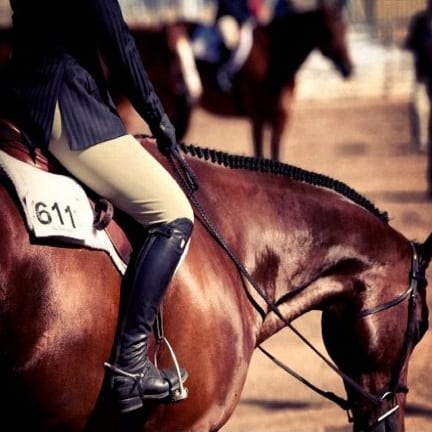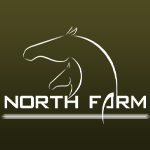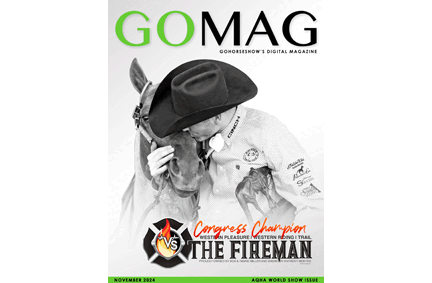The first two installments of GoHorseShow.com’s “We Ask the Judges” series covered Showmanship and Horsemanship and was hugely popular with our readers. The next discipline in the series is Hunt Seat Equitation. We talked to AQHA judges, Jerry Erickson, Kelly Boles Chapman, and Christa Baldwin. Let’s see what interesting insight these industry leaders have regarding this challenging class.
Question #1–What is your biggest pet peeve with regard to this class?
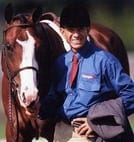 Jerry Erickson–I actually have two major pet peeves and look for this position in every equitation rider. To me the head, neck and shoulder is controlled by the reins and there must be a straight line from the elbow to the wrist to the bit. A limp and broken wrist with the knuckles pointing straight down make me crazy. Also the body of the horse, ribs and haunches are controlled by the rider’s legs which is impossible when the rider has the leg pulled so far back that the toe is behind the girth. Both of these position’s greatly affect my view of this exhibitor as a rider versus a perched passenger.
Jerry Erickson–I actually have two major pet peeves and look for this position in every equitation rider. To me the head, neck and shoulder is controlled by the reins and there must be a straight line from the elbow to the wrist to the bit. A limp and broken wrist with the knuckles pointing straight down make me crazy. Also the body of the horse, ribs and haunches are controlled by the rider’s legs which is impossible when the rider has the leg pulled so far back that the toe is behind the girth. Both of these position’s greatly affect my view of this exhibitor as a rider versus a perched passenger.
 Kelly Boles Chapman–No engagement in the rider’s seat and/or leg….those that just sit there as barely even a passenger. There are many very well-schooled pattern horses that help to attempt to camouflage a poor rider. Also, when the rider goes right to their spur and leave their leg “open” (i.e–daylight between the horse and the riders knee, calf, etc); and also extremely long spurs bother me.
Kelly Boles Chapman–No engagement in the rider’s seat and/or leg….those that just sit there as barely even a passenger. There are many very well-schooled pattern horses that help to attempt to camouflage a poor rider. Also, when the rider goes right to their spur and leave their leg “open” (i.e–daylight between the horse and the riders knee, calf, etc); and also extremely long spurs bother me.
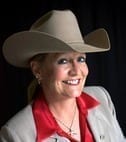 Christa Baldwin–Probably, my biggest pet peeve is dirty boots. Also, arched, stiff backs and nodding at the end of the pattern to the judge. Just finish your pattern and ride away, do not look back and nod.
Christa Baldwin–Probably, my biggest pet peeve is dirty boots. Also, arched, stiff backs and nodding at the end of the pattern to the judge. Just finish your pattern and ride away, do not look back and nod.
Question#2–What sets your winner apart from the rest?
Kelly Boles Chapman–For me, a winner sets themselves apart by being an engaged rider…..a smoothly executed pattern that displays the rider’s strengths, and shows me they have “feel” in their hands, seat and legs. I love the patterns that have one or no cones….I want to see how they best present their skills.
Jerry Erickson–The winner is the rider who shows me they have control of the horse using the correct body position in a relaxed and confident manner.
Christa Baldwin–An exhibitor that is a team with their horse and is going forward in their gaits and through their movements. Someone that knows they want to lay out the best pattern they can so they are riding forward with confidence, knowing that whatever they ask of their horse next he will give it and give it willingly. Horses tell on their riders if they are not between their hands and legs and listening. Their head will go up in resistance or they will hollow their back and back off of going forward. Great legs are very important to me also- heels down and legs on the horse pushing that horse into the bit so there is communication between horse and rider.
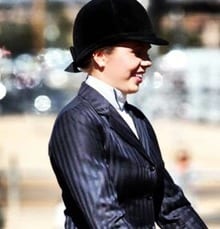 Question#3–If you could give one piece of advice to an exhibitor, what would it be?
Question#3–If you could give one piece of advice to an exhibitor, what would it be?
Christa Baldwin–Ride your horse forward and make it smooth.
Jerry Erickson--Relax and ride–of course exhibit equitation form but not in a stiff and rigid fashion. Simply follow the motion of the horse.
Kelly Boles Chapman— Tenacity and commitment to the sport will serve them well! If they don’t work with a trainer, try and get good instruction when they can, and set clear goals for themselves that don’t necessarily involve horse show placings. Particularly in the equitation, time spent on the longe line working at the two-point, posting without irons, etc, can really improve their balance, timing, and stability.
Question#4–What do you feel about the new trends in english attire?
Christa Baldwin–There is so much hoopla about shirts, colors etc. I don’t want an exhibitor to come out in bling or in a gawdy outfit, but I actually like the dark colored shirts and the reds etc. They dont bother me at all. I am more interested in finding a rider that can show me what they can do with the pattern and that I would like to take home and ride my own horses.
Jerry Erickson–In regards to the turn out of the rider, I rarely notice unless it is extremely garish. There is no place in this event for bling, and I do feel that some push it a bit to far with the dark and print shirts. However, so little shows under the jacket that again I rarely notice. If the hair is neat, I don’t care how the rider puts it up. Frankly, I think the khaki breech looks the best, and I would think they are helpful to the rider who is fortunate enough to have an excellent figure. The riders body type is clearly part of the first impression, however, the effective rider gets bonus points for being an effective rider regardless of the body shape.
Kelly Boles Chapman— Rarely do I notice the shirt etc when I’m judging, unless it is so garishly loud that I find it offensive. For my own daughter and students, I prefer traditional and conservative — a white or light-colored shirt with no noticeable pattern in the equitation for sure. No bling ever in the hunt seat on a jacket or shirt. The jacket must fit well – not large and sloppy. Hair should be neat — and usually someone’s personal haircut/style dictates how they can wear it under their hunt cap. If their hair is long, I have my students wear it over their ears, not behind, but I think that is a minor issue as long as it is neat. No big softball bun, bow, or ribbon-adorned hairnet on a bun. As far as the color of breeches, first, the exhibitor needs to be aware of what their rulebook states (some state no white, or black). I think there are at least fifty shades of khaki, sage and tan and I’d say rust is out.
 Question#5–What about equitation style–Is it better to be in a forward seat, or have a more upright body. What about the hands, wide or close?
Question#5–What about equitation style–Is it better to be in a forward seat, or have a more upright body. What about the hands, wide or close?
Jerry Erickson–Your question about equitation style gives me the choice between two upper body positions when in reality I prefer something in the middle. Not totally forward but I am very comfortable with a slight bend at the waist. Hands should not be too wide–my thinking is that there is a triangle from the bit to the hand to the wither. The wider the base of this triangle is the more room the horse has to shift his neck and shoulders into. The closer the hands are thus a narrower triangle the more control of the front end. I like the iron to be at the girth and being able to see part of the girth in front of the boot laces.This is where the leg of the over fence rider would be positioned. The extreme horsemanship position you refer to has no place in any class be it western or English tack! My thinking is that the upper body should be a square shoulder in line with the riders hips, not necessarily in front of and definitely not behind.
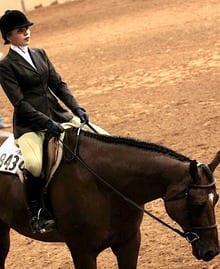 Kelly Boles Chapman–First, on the hands — I think that to have true “feel”, the rider’s hands should be quiet and soft, not “perched” or stiff looking. Sometimes, the rider will need to adjust the width of where they hold their hands to most correctly pilot their horse through the class. As far as upright or more forward seat–at the hunter shows, in the equitation on the flat, riders generally seem to be in a more forward position; at AQHA or APHA events, we see riders more “upright” in their style. This doesnt mean one or the other is right — it is stylistic difference between the sectors. I don’t think posting is in an “up” motion (such as in saddleseat) but more forward with the hip and pelvis; sometimes riders do over-thrust /over post, ie, throwing their hips far in front of their shoulders, causing them to appear even as if they are leaning back; I think this is a cause for unbalance particularly in an equitation class. Driving forward with the seat can encourage length of stride, but the balance of the rider in shoulder, hip and heel should be maintained in equitation.
Kelly Boles Chapman–First, on the hands — I think that to have true “feel”, the rider’s hands should be quiet and soft, not “perched” or stiff looking. Sometimes, the rider will need to adjust the width of where they hold their hands to most correctly pilot their horse through the class. As far as upright or more forward seat–at the hunter shows, in the equitation on the flat, riders generally seem to be in a more forward position; at AQHA or APHA events, we see riders more “upright” in their style. This doesnt mean one or the other is right — it is stylistic difference between the sectors. I don’t think posting is in an “up” motion (such as in saddleseat) but more forward with the hip and pelvis; sometimes riders do over-thrust /over post, ie, throwing their hips far in front of their shoulders, causing them to appear even as if they are leaning back; I think this is a cause for unbalance particularly in an equitation class. Driving forward with the seat can encourage length of stride, but the balance of the rider in shoulder, hip and heel should be maintained in equitation.
Christa Baldwin–They should not be as forward as riding to a fence because they are not riding to a fence in equitation on the flat nor are they going at a hand gallop on the rail unless asked. If they are asked for the hand gallop then they should be more forward. However, as I stated before one of my pet peeves is the overly arched, stiff upper body. I prefer legs to be closer to underneath your body but not as far back and straight underneath you as in horsemanship. I prefer the leg slightly behind the girth and not on top of it. When the leg is right over the girth it makes a rider look like they are riding in a chair seat and falling back–especially when they are shorter legged. They don’t look balanced. The post should be forward and between the hands and not an up and down motion. At the canter, they should not lean back because they will be behind the motion of the horse nor should they be too forward because most exhibitors that are leaning forward are doing so because they are nervous and worried. The hands should be a few inches apart making a nice straight line from the elbow to the bit. If they are too wide, it looks like they are trying to school their horse and if they are too close it gives them an appearance of being rigid.
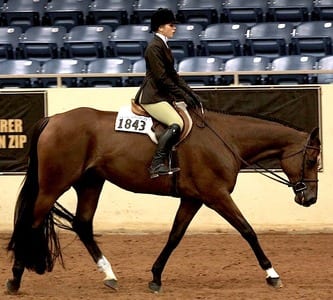 Question #6–What about rein length in equitation?
Question #6–What about rein length in equitation?
Kelly Boles Chapman–Absolutely no drape–must have light contact. If someone wonders why that is — try riding to a fence with a drape in your reins. Good luck. For those that say equitation is not about going over fences, again, I believe this class is a platform for other aspects of this discipline, which theoretically could include fences.
Christa Baldwin–To me they should have a soft contact with the mouth. Loose sloppy reins in equitation are not acceptable.
Question#7–How important is horse type in equitation? Western style horse versus english.
Kelly Boles Chapman— Western or hunter type horse in the equitation makes no difference to me.
Jerry Erickson–I really have no problem with an all around horse that is more western type in an equitation class–as long as the rider is not in a western position and finds a hunter type position.
Christa Baldwin–We can’t dictate what everyone owns and what classes they want to show in. That is the American Quarter Horse’s virtue -the versatility. But what an exhibitor can do is show that horse forward and try to bring out the best in that horse for that class that they can. I try to judge on how well prepared that exhibitor is for that class and if they are showing that horse to the best of their ability. Are they showing the horse with impulsion and confidence?
 Question#8–What is the importance of speed in your patterns?
Question#8–What is the importance of speed in your patterns?
Kelly Boles Chapman–Speed in the pattern clearly is relative, and adds to degree of difficulty. For example, a sitting trot that is performed a pleasure-speed jog is definitely not credit earning. In equitation and hunter under saddle, the class is to be performed at a trot and a canter, not a jog and a lope. Forward motion is expected.
Christa Baldwin–To me it is not about speed but impulsion–two very different things. Again, I want an exhibitor to lay it out there with forwardness and impulsion and smoothness. The last thing I say to my clients before they go into the ring-SMOOTH. If it is too fast for that exhibitor, it will not be smooth. If it is too slow, it will look ugly and it will not be smooth. Find your happy medium and work on increasing the impulsion in every manuever. Speed is good if you can handle it, and it is a higher degree of difficulty–just dont lose the smoothness and team look you want to create.
Jerry Erickson–Speed in not really necessary for me, efficient, clean and error free are more important.
Question#9–Anything else you would like to add?
Christa Baldwin–I just feel it is important to keep encouraging judges to open up the patterns and let the exhibitor show what they can do with their horse. Whether they have a tall horse or a smaller built horse they can show it to their best if it is opened up and set bigger.
*Thanks to Stephanie Willsey and 9-time AQHA World Champion, Must Be A Detail, on letting us use pictures of her and Stewie for this article.


